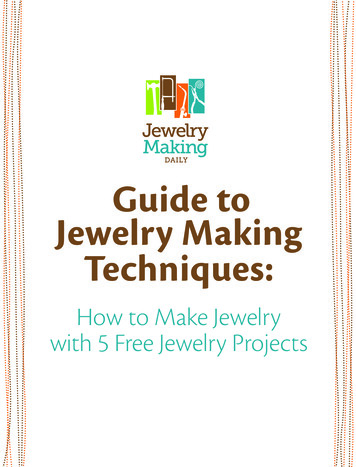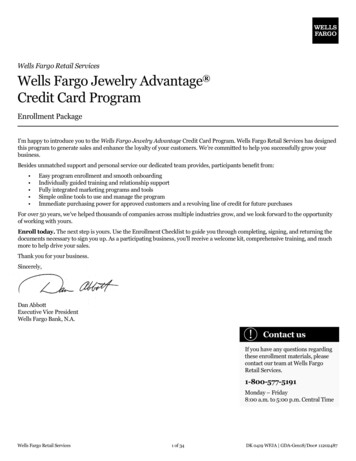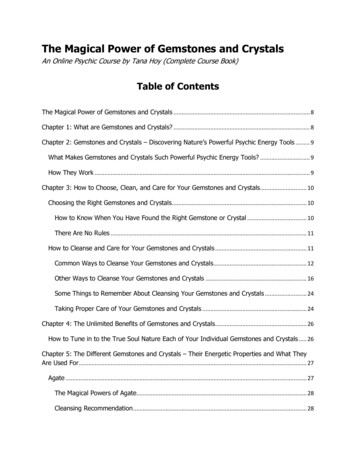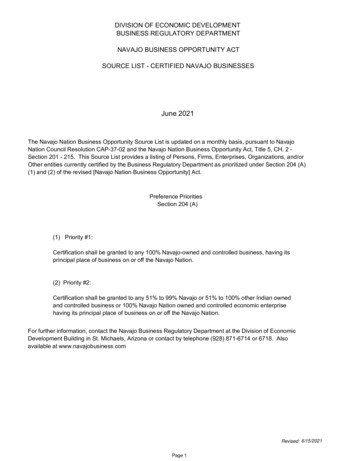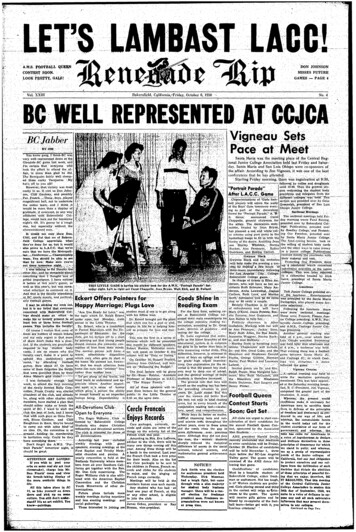
Transcription
Guide to MakingJewelry with Beads:Create Handmade Beaded Jewelryfrom Your Own Bead Jewelry Designs
Guide to Making Jewelry with Beads:Create Handmade Beaded Jewelry from Your Own Bead Jewelry DesignsNecklace Making: Five Ideas forDesigning Beaded Necklacesby Jennifer VanBenschoten p. 1Four Fun Ideas forEarring Making!by Jennifer VanBenschoten p. 3Sketching Beading Designs:Examples and Ideasfrom Readersby michelle mach p. 54 Sketched Ideas for BeadedNecklace ShapesHexagonal NettingBrick Stitch Increasesand decreasesby jean campbell p. 7by Dustin Wedekind p. 9by Dustin Wedekind p. 11Two-drop odd-countpeyote stitchsingle-needleright-angle weaveBead Be Bangled Braceletby Dustin Wedekind p. 13by jean campbell p. 15by nancy jones p. 17Link NecklacePotato Chip NettingLady’s Slipper Earringsby eileen arnstein p. 19by bonnie voelker p. 20by laurie nelson p. 22Contentsii
Guide to Making Jewelry with Beads:Create Handmade Beaded Jewelryfrom Your Own Bead Jewelry Designs“Where did you come up with the idea for that?”I hear that all the time when I’m showing someone a pieceof my handmade beaded jewelry. And really, if you knowwhere to look, you’ll find beaded jewelry design ideas allaround you. Coming up with beaded jewelry design ideas canbe as easy as playing around with your favorite beadweavingstitch!If you love making handcrafted beaded jewelry, you’ll loveour new free eBook, our Guide to Making Jewelry with Beads:Create Handmade Beaded Jewelry from Your Own Bead Jewelry Designs. We’ve selected some of our best jewelry designblogs, beading stitch tutorials and then added a sample of freebead jewelry patterns to show you how each beading stitchcan be altered and modified to create a unique piece of handcrafted beaded jewelry. Need a few good ideas to get you started? Check out ourfavorite blogs about beaded jewelry design ideas, includingfive ideas for making beaded necklaces, four fun ideas formaking beaded earrings, sketching ideas for beaded necklaceshapes, and examples straight from the sketchbooks of ourreaders about how to sketch out your beaded jewelry designs! Try Dustin Wedekind’s instructions for brick stitchincreases and decreases to learn more about how to shapethis very versatile beadweaving stitch. Then try Nancy Jones’Bead Be Bangled bracelets to see how brick stitch is used tocreate these easy-to-wear beaded bracelets. Next, learn how to do two drop odd-count peyote stitchwith Dustin Wedekind’s directions. This popular variation onpeyote stitch can be used to create shape and texture in yourbeaded jewelry designs. Follow up with Laurie Nelson’s lovelyLady’s Slipper Earrings to see how shaped peyote stitch can be usedto make beaded flower petals. Netting can be used in so many different ways to create wonderfulbeaded jewelry designs, and Dustin Wedekind’s hexagonal nettingtutorial illustrates how this beading stitch can be modified to createlovely shapes. Bonnie Voelker’s Potato Chip Netting project takes itone step further and uses free-form netting to create one-of-a-kindbeaded jewelry. Right-angle weave is probably the most loved and feared beadingstitch around. But never fear – in Stitch Pro by Jean Campbell, shetakes the guesswork out of single needle right-angle weave. Onceyou’ve mastered right-angle weave, try Eileen Arnstein’s Link Necklace,composed to right-angle weave chains that are linked together asyou stitch them!So the next time you feel like making beaded jewelry, sit downwith these handy references and see what comes out of your ownimagination! Who knows? You might find that you have morebeaded jewelry design ideas in you than you ever thought possible!Bead Happy,JenniferJennifer VanBenschoten, Beading Daily editorGuide to Making Jewelry with Beads:editor, beadingdaily JENNIFER VANBENSCHOTENphotography JOE COCA, ANN SWANSONProjects and information are for inspiration and personal use only. BeadingDaily, Beadwork, and Stringing do not recommend, approve, or endorse any of the advertisers, products, services, orviews advertised in this publication. Nor do BeadingDaily, Beadwork, or Stringing evaluate the advertisers’ claims in any way. You should, therefore, use your own judgment in evaluating theadvertisers, products, services, and views advertised in BeadingDaily, Beadwork, and Stringing.iii
Necklace Making: Five Ideas forDesigning Beaded NecklacesJennifer VanBenschotenTry Dustin Wedekind's RightAngle Bezel if you are bored withmaking peyote stitch bezels for yourcabochons and rivolis.Try Dustin Wedekind'sRight Angle Bezel if youare bored with makingpeyote stitch bezels foryour cabochons and rivolis.Necklace making is something thathas always come easy for me. Evennow, I find that my sketchbooks arefull of more necklace designs thananything else, and I'm always findinginspiration for new designs everywhere.My process for designing and making a beaded necklace depends onwhere I get my idea for the finishedpiece. Usually, a cabochon or otherfocal bead is the starting point formaking my necklace, as I designaround that. I'll draw my colors fromthe colors in the focal piece and thenfigure out what beading stitch or beading technique will be used for the rest ofthe piece.But sometimes I sit down with thebeads and I have no idea where tostart. When my necklace making ideasdry up, there are a few things that I'lldo to give my beady brain a little bit ofa jump-start. Here are five ideas fornecklace making when you need a little inspiration for a new beading project!1. Bezel something.Take a crystal stone, a gemstonecabochon, a bottle cap filled withresin, an old Scrabble tile - you canstitch a beaded bezel around prettymuch anything to turn it into a pendant for a beaded necklace. If you'rebored with making peyote stitchbezels, try something different –– useright-angle weave or herringbonestitch to create a unique beadedbezel, and play around with shapingyour beaded bezels.Alkia Kalaida's Roped In Turkishcrocheted beaded rope is a perfectexample of how a simple beaded rope canbe turned into a bold beaded necklace.2. Make a beaded rope.Embellished or not, a great way to getyour creativity flowing is to just sitand make a beaded rope. Start with asimple spiral rope, or try somethingnew like bead crochet or a tubularvariation of your favorite beadingstitch. You can either use your beadedrope just as it is with no other embellishment, or add drop beads, daggers,glass flowers or a fabulous handmadefocal bead!Make a fast and fabulous beadednecklace like Perie Brown's Sophisticated Fringe necklace.Make a fast and fabulous beaded necklace like Perie Brown's SophisticatedFringe necklace.Alkia Kalaida's Roped In Turkishcrocheted beaded rope is a perfect example of how a simple beaded rope canbe turned into a bold beaded necklace.More wonderful beadwork projects are available at shop.beadingdaily.com/jewelryprojects 2012 Interweave Press LLC. Not to be reprinted. All rights reserved.page 1
3. Beaded Fringe.You can't get much easier than thisidea for beaded necklace making.String a length of beads, attach aclasp, and then attach a new thread inthe center and start making beadedfringe! Fringe necklaces are fast andfun, depending on how much andwhat kind of fringe you want to use.Add gemstones for a more naturallook, or use funky glass beads toaccent your fringe. Try makingstrands of long, looped fringe for athicker necklace.4. Freeform beadwork.Freeform beadwork is an excellentway to make a unique necklace out ofleftover bits of beadwork. Using leftover bits of beadwork for freeformbeadwork is less intimidating thanstarting from scratch with just a pileof beads. It's also a great way to getyour creative juices going as you thinkabout ways to connect these pieces ofbeadwork into a necklace!5. Make a beaded bead.If you're making a necklace that isprimarily just strung beads and wantto add a dash of beadweaving, stitchup a quick peyote beaded bead. Youcan string it on a headpin to make adangle or slide it over a section of finechain to be the focal point of yournecklace. Making beaded beads is alsoa fabulous way to use up little bits ofleftover seed beads!Bead Happy,JenniferMore wonderful beadwork projects are available at shop.beadingdaily.com/jewelryprojects 2012 Interweave Press LLC. Not to be reprinted. All rights reserved.page 2
Four Fun Ideas for Earring Making!Jennifer VanBenschotenEven if you don't have a beadingpattern handy, there are lots of waysthat you can just pick up your beadsand start making earrings. Sometimesworking without a pattern can be veryintimidating, but try one of these fourideas for earring making and find outjust how much fun it can be to designyour own beaded earrings!Easy and fun: use simple brick stitchdiamonds and lots of easy fringe tomake a pair of Nancy Zellers' DiamondFringe Earrings.When I first started learning howto bead and was learning basic jewelry-making, I loved earring making. Ididn't realize it at the time, but making earrings a great way to learn newbeadweaving stitches and jewelrymaking techniques. Handmade earring projects are (usually) small andnot terribly overwhelming, so theymake perfect beading projects whenyou don't have a lot of time or justneed to use up a few leftover beads.Earring making is also a great wayto get a little beading time in duringthe busy holiday season. Beaded earrings make great gifts, especially if youneed a last-minute gift for a friend orco-worker. Or maybe you just need a little something to jazz up your favoritewinter sweater - a new pair of earringscan really breathe new life into a favorite blouse!bead loop! Or string your beaded beadon a head pin with a couple of crystalbeads and you've got a little bit of glitzyou can hang from your ears.3. Beaded fringe.Beaded fringe isn't just for beadednecklaces and amulet bags! Makingearrings from beaded fringe is a fastand easy way to make earrings with aserious "wow" factor. Gather a few leftover beads, shells, pearls or crystalsthat match your seed beads and useleaf fringe or stick fringe to makesome lush (but lightweight) beadedearrings. Or use beaded fringe to makeearrings that complement a beadednecklace when you don't want to take1. Make a brick stitchdiamond.This is pretty basic, but makingearrings can't get much easier thanthis. Stitch up a simple brick stitchdiamond using your favorite beads cylinder beads, cube beads, or throwin a big fire polished bead into thecenter of the diamond. Make somefunky fringe with a few leftover buglebeads or maybe some long loops ofseed beads, and you have the classic(but updated!) beaded earring. Or justleave the diamond without any fringeand hang it from your favorite earringfinding.Your basic peyote-stitched beadedbead can get a little dressed up tomake Mary Tafoya's Peyote TasselEarrings.2. Beaded beads.I just have a thing for those easy little peyote-stitched beaded beads. Ittakes literally minutes to stitch up alittle piece of peyote and then zip itup. Add some more fringe or a fancyedging and hang it from a tiny seedYour basic peyote-stitched beaded beadcan get a little dressed up to make MaryTafoya's Peyote Tassel Earrings.More wonderful beadwork projects are available at shop.beadingdaily.com/jewelryprojects 2012 Interweave Press LLC. Not to be reprinted. All rights reserved.page 3
too much attention away from thenecklace itself!Practicing your beaded bezels canbe fun and beautiful when you stitchup a pair of Cecilia Guastaferro'sRoyal Amethyst Earrings.4. Practice your beadedbezels.You can stitch a tiny bezel aroundalmost anything. If you have a coupleof crystal stones hanging around (orScrabble tiles, old typewriter keys, bottle caps or something else that wouldmake a funky earring) grab some seedbeads and stitch a beaded bezel. Use aseed bead loop to hang a dangle fromthe bottom, or just stitch a jump ringto the top for easy attachment to anearring finding. You can even stitchtiny bezels around gemstone beadsand accent them with crystals andpearls for attention-grabbing earrings.Practicing your beaded bezels can befun and beautiful when you stitch up apair of Cecilia Guastaferro's RoyalAmethyst Earrings.Find great earring making ideas likethese fun felted ball earrings by DustinWedekind.Bead Happy,JenniferMore wonderful beadwork projects are available at shop.beadingdaily.com/jewelryprojects 2012 Interweave Press LLC. Not to be reprinted. All rights reserved.page 4
Sketching Beading Designs:Examples and Ideas from Readersby Michelle MachBack in April, I wrote about how Isketched the design for my chainmaille necklace ("Rambling Rose"). Ihad so many emails from beaders whoalso sketched their designs that Idecided to ask everyone--Do yousketch your designs?More than 1,300 responded andonly 26% answered "no." The "yes"group was divided between those who"always" (21%) sketched and thosewho only "sometimes" (53%) did.A few surprises for me: The firstsurprise was how some beaders usesketching as a way of working withcustomers. I'd never thought of thatbefore, but it makes sense for customdesigns. Otherwise, you'll waste a lotof time and materials. Another surprise was how much technology hasinfluenced the sketching process.When I'm relaxing with my beads, itnever occurs to me to open up mycomputer! But the biggest surprise forme was learning how beadmakers usesketching. When I asked the question,I was thinking about beaded piecesand not individual beads. But itmakes a lot of sense for beadmakersto sketch, particularly if they plan onre-creating their designs. Here's whatelse I learned:For so many of us who work withtiny little seed beads, we end up doingit for the love of it. Not because there’sa future in selling our handiwork. Infact, rarely does it seem as though wecould make money on bead creations,as it takes so many hours of our time.Not so with wire. You really canwhip up a piece of jewelry in a matterof minutes. Additionally, wire is a veryforgiving medium. If you make awrong bend, you can usually justunbend it!Those who did not sketch felt thatthey didn't need to or that drawing wastoo difficult or too time-consuming."I guess I'm just wired differently. Istand and stare at the materials andwork it out in my head.""Most of the time I enjoy watchingit come to life from my thoughts as Igo. Usually thinking ahead takes thespontaneity out of my ideas. I know ifI do it in my head and adjust as I go,probably it will be one of a kind."Sketch and finished bead by lampworkartist Lori Peterson. She uses sketchesto make sure her proportions are right.Of course, by just askingthis question, I managedto change a least one person's mind:"When this survey first came out Isaid NO, but since then, I have startedand you know what? It really helps!Even though my drawings are prettysketchy, it helps me look at my ideasbefore I go pulling beads out! I hadnever sketched a design until lastweekend. I needed to figure out howthe design was going to look using certain numbers. Instead of my usualway, just putting the beads on thewire, I actually put it on paper. Musthave been because I read the questionin Beading Daily!"A few reasons forsketching included figuring outdesign problems, capturing inspiration, saving time, saving money, keeping a record of ideas, planningprojects for classes, and working withother people. Many designers did notsee their sketches as absolute andchanged them as they designed."[I sketch] only for commissions,otherwise my designs sort of 'grow' inmy head. I usually have a very clearidea of what I want and only usesketches when I have to convey ideasto others"."I work a lot in silver, so I do sketchesso that I don't waste the silver."More wonderful beadwork projects are available at shop.beadingdaily.com/jewelryprojects 2012 Interweave Press LLC. Not to be reprinted. All rights reserved.page 5
Work (especially duringmeetings) was a popularplace to work out designs."I sketch my designs partly to keepmy mind busy while I do a boring telemarketing job. I can come up with anidea and explore it when I get home.""I am day bartender down here inSarasota. While working, somethingwill come to mind and I sketch myideas on bar napkins!"Sketching materialsvaried greatly.Some beaders used special pens,colored pencils, paper (lined, graphed,plain, art). Other tools mentionedwere charcoal, mechanical pencils,and watercolors. One beader has covered her beading notebook in beads!"I try to keep everything in one notebook, but sometimes I use whatever'shandy to make notes or draw on.""I sketch on random Post-It notes,but then I'm way too young to be organized. Maybe when I get older andwiser I will move into a notebook!""I use a 5"x7" notebook and generallyuse a purple-ink pen. Purple ink is bliss.""I keep a rubber band around thenotebook, as I generally clip photos ofthings I visualize beaded up frommagazines and ads. I also have littlePost-It notes in the book, usually ofcolor schemes I find interesting whileI am walking the streets of New York."Some beaders wentbeyond the one-time sketch.They created entire notebooks,dated their designs, and added notesafter they created the design. Thisway, they had a record of their creative journey. And one beader admitted to sketching her designs after theproject was completed, not before."Comments both good and bad arealso recorded, so if I redo the design Iwill be able to remember where I'vehad any problems and how long theassembly took. Keeping a record bookreally helps document my beadingjourney and shows how far I've come.It's kind of like a Beaders Bragbook."I love that idea! Even if you don'tsketch, you might consider creatingyour own "bragbook" of photos of yourdesigns. I bet you'll amaze yourself!"I use a sketch book called Circa(from Levenger.com). It's olive greenleather notebook binder, fits 8½"x11"grid paper, and is embossed with mycompany name. The Circa option isgreat, it allows me to insert paperwhenever needed, and when thedesign piece is finished, I can attach apicture of the final piece and remove itfor filing. It's perfect!"Technology hasimpacted sketching.Some readers had design systemsor used programs on the web like FireMountain's virtual beadboard. Othertools mentioned were graphic programs like Photoshop Elements andMS Paint, as well as the drawing toolsin Microsoft Word."I have found it easier to use thecamera on my phone to take a pictureon my inspiration so I never miss athing. After downloading the picturesof a leaf that spoke to me, I find thatviewing all the pictures togethersometimes leads me in a completelydifferent path. Sometimes I even find Ichange the materials as well.""I like to use the stylus and touchscreen of my IPAQ Pocket PC. It goeseverywhere with me!""MS Paint is my swiftest sketchtool; I use it to check visual balanceand colour harmony, and to rough outhow many of each type of bead I'llneed to fill a length."Sketch and finished polymer clay caneby artist C.A. Therien.She scales herdrawings down and uses them astemplates for her designs.More wonderful beadwork projects are available at shop.beadingdaily.com/jewelryprojects 2012 Interweave Press LLC. Not to be reprinted. All rights reserved.page 6
4 Sketched Ideas for Beaded Necklace Shapesby Jean CampbellMelinda Barta asked me recently todesign a necklace for a project she'sleading. The deadline is right aroundthe corner, so I've been madly stitching, trying to come up with somethingI'm excited about. I came up with afocal piece that I'm happy with: a freeform peyote-stitched flower with amulti-pearl center. It's pretty, colorful,and fun to make. But the next task isto turn that pretty flower into a pieceof jewelry. Hmm. I could slap a pinback on it and call it a day, but I don'twear brooches that often in the summer and this is a very summery piecethat I'd like to wear. The flower is toobig and showy for a bracelet, so it'sdefinitely got to be a necklace.Because I'm on a tight deadline, I'vebeen looking around for ideas on howto incorporate the flower into a strungnecklace design. Revisiting my copy ofStringing Style, a book with dozens ofunique necklace, bracelet, and earringdesigns (it also happens to be on saleright now for 75% off at the Hurt Bookand Overstock Sale!) is what prickedmy creativity. Paging through thislovely book of strung designs provedto be a great inspiration: I took to mysketch book and played around withsome necklace shapes. Here are fourthat I think will be good candidatesfor my flower:Do you sketch out your designs,too? Perhaps you've used these shapesin your necklace designs? I've justshown four here, but of course, thepossibilities are endless!Happy beading-TraditionalFor this design, I'd go oldschool, placing the flower at thecenter and stringing the sideswith leaves and pearls. Perhapsa flower toggle clasp to closethe ends?More wonderful beadwork projects are available at shop.beadingdaily.com/jewelryprojects 2012 Interweave Press LLC. Not to be reprinted. All rights reserved.page 7
LariatFor this style, I'd stitch somesort of tube on the back ofmy flower, string a strand (orstrands?) of seed beads thatwould fit over my head andthrough the tube, then addbig pearls to the ends of thestrand(s). The tube would allowme to slide the flower up anddown the strands.Multi-strandFor this over-the-head necklacewith no clasp, I'd use the flowerpetals to connect straight-upstrands of pearls interspersedwith a strand of chain and pearls.It would look especially nice withthe flower over to one side.ChokerI'm at an age that I don't reallywant to wear chokers anymore,but if I were to give this necklaceto my daughter, who has a beautiful neck, it would look great.I'd sew a multi-strand clasp tothe back of the flower and stringstrands of pearls between theclasp ends. I suppose this wouldmake for a nice bracelet, too; I'djust have to make the flower abit smaller.More wonderful beadwork projects are available at shop.beadingdaily.com/jewelryprojects 2012 Interweave Press LLC. Not to be reprinted. All rights reserved.page 8
Hexagonal Nettingby Dustin WedekindMaterialsSize 15 , 11 , or 8 seedbeads in 2 colors (A and B)Beading needle and threadInspired by Ernest Haeckel’s century-old illustrations in ArtForms in Nature (Prestel-Verlag, 2004), I set out to createa lacy, spiky, organic anything. The six-sided hexagonis a favorite of the natural world, from honeycombs tosnowflakes. These samples are worked in rounds from thecenter out, forming a brick-stitch sort of lace. While every“unit” has the same number of beads, each round will havesix increase units, one at each corner, to keep the netting flat.More wonderful beadwork projects are available at shop.beadingdaily.com/jewelryprojects 2012 Interweave Press LLC. Not to be reprinted. All rights reserved.page 9
1: Use a comfortable length of single thread to string 12A; pass throughthem all twice to form a snug circle.Work 6 units (loops) around the circle:Unit 1: String 10B; skipping 2beads, pass under the thread of theprevious round, pull snug and passback through the last 2 beads juststrung (Figure 1).Units 2–5: String 8B; skip 2beads, pass under the thread, andpass back through the last 2 beads(Figure 2). Repeat three times (Figure3). To help position each stitch, keepthe working thread in place as youpull snug and pass back through thelast 2 beads.Unit 6: String 6B; pass backthrough the first 2 beads of Unit 1,loop under the thread, and passthrough the first 4 beads of Unit 1(Figure 4).2: Arrange your work so that thethread is exiting the left side of the topunit.Unit 1: String 10A and stitch (asin Step 1) so that they are centered onthe previous unit (Figure 5).Unit 2: (side): String 6A andstitch between the second and thirdbeads in the next unit (Figure 6a).Unit 3: (corner): String 8A andstitch between the next pair of beadsin the same unit (Figure 6b).Unit 4–11: Repeat Units 2 and 3.Unit 12: String 4A and finish theround as in Step 1 (Figure 7).Figure 1Figure 5abFigure 2Figure 6Figure 3Figure 7Figure 4Figure 83: Continue each round as in Step2, working 2 side units between eachcorner unit (Figure 8). The followinground will have 3 side units, followedby a round with 4 side units and so on.More wonderful beadwork projects are available at shop.beadingdaily.com/jewelryprojects 2012 Interweave Press LLC. Not to be reprinted. All rights reserved.page 10
Brick Stitch Increases and decreasesby Dustin WedekindMaterialsSeed beads (Aand B)ThreadPin backToolsBeading needlesScissorsIncreases and decreases in flat brick stitch form neatdiamonds; passing through the edges of the diamondswill cup the work, making excellent leaves, or in this case,shamrocks. This increase adds 1 bead to a row, half a beadat each end. It happens at the start of a row by stringing2 beads and passing under the first loop of the previousrow; the final two stitches pass under the same last loopof the previous row. The decrease stitch skips a loop of theprevious row, shortening each row by one bead.More wonderful beadwork projects are available at shop.beadingdaily.com/jewelryprojects 2012 Interweave Press LLC. Not to be reprinted. All rights reserved.page 11
IncreaseRows 1 and 2: String 1A and2B; pass through them again, leaving a4” tail to hold onto while you work.Pass through the first 2 strung; the 1Ais the first row, the thread should beexiting between the 2B (Figure 1).Row 3: String 2A; pass under thethread between the 2B and pull tight.Pass back through the last bead juststrung (Figure 2). String 1A and passunder the same loop of thread andback through the bead just strung(Figure 3). Secure this last stitch bypassing through the last 2 beads ofthis row; this will hold the loop ofthread in place as you begin the nextrow (Figure 4).Row 4: String 2B; pass under thethread between the last 2 beads of theprevious row, pull tight, and pass backthrough the last bead strung. *String1B and pass under the next loop andback through the bead just strung.Repeat from *, passing under the sameloop (Figure 5). Secure the last 2 beadsof this row.Row 5: String 2A; pass under thethread between the last 2 beads of theprevious row and back through thelast bead strung. *String 1A and passunder the next loop and back throughthe bead just strung. Repeat from *twice, passing under the same loop forthe last 2 stitches. Secure the last 2beads of this row.Row 6: Repeat Row 5 (6B total).Row 7: Repeat Row 6 (7A total,Figure 6).DecreaseRow 8: String 2B; pass under thesecond-to-last loop of thread of theprevious row, pull tight, and pass backthrough the last bead strung (Figure7). String 1B and pass under the nextloop and back through the bead juststrung; repeat to the end of the row.Row 9: Repeat Row 8 (5A total).Row 10: Repeat Row 8 (4B total).Row 11: String 3A and pass downthrough the beads along the oppositeedge to exit the first row (Figure 8).Pull taut to cup the leaf slightly.Shamrock AssemblyRepeat Rows 1–11 for a second leaf.After passing through the edge beads,connect to the previous leaf by passup through 3 of its edge beads, thendown through the last 3 of the currentleaf (Figure 9). Repeat to make 2 moreleaves. For a stem, string 12 beads,alternating A and B, then skip the lastbead and pass back through the others. To make the stem bend, skip oneof the beads as you pass back through.Pass through a few beads of a leaf andattach a pin back. FDustin Wedekind is senior editor ofBeadwork magazine. If you have seedbead insights, requests, or inquiries,please e-mail beadwork@interweave.com.Figure 5Figure 6Figure 7Figure 1Figure 2Figure 8Figure 3Figure 9Figure 4More wonderful beadwork projects are available at shop.beadingdaily.com/jewelryprojects 2012 Interweave Press LLC. Not to be reprinted. All rights reserved.page 12
Two-drop odd-count peyote stitchby Dustin WedekindMaterialsSeed beads (A, B, and C)Beading threadToolsBeading needleScissorsOur beaded tube combines two variations of flatpeyote stitch: two-drop, which means two beads perstitch, and odd-count, which means an odd numberof stitches per row and requires a specific turn atthe end of every other row. Using three colors ofbeads helps you see how the rows fit together.More wonderful beadwork projects are available at shop.beadingdaily.com/jewelryprojects 2012 Interweave Press LLC. Not to be reprinted. All rights reserved.page 13
Step 1: Use a needle with 2’ ofthread to string 1A. Pass through thebead again, leaving a 4” tail, thenstring 2B and 1A seven times. Thesebeads are the first two rows and willbecome staggered when you work thethird row. The first bead is a tensionbead, which will keep the beads on thethread while it allows the beads roomto shift.Row 3: String 1C and pass backthrough the last 2B strung (Figure 1).Repeat for the length of the row. Forthe last stitch, string 1C and passthrough the first A (Figure 2). Thisend-of-row turn places the fourth rowon top of the first row and only worksat the beginning—the rest of the rowswill be worked on top of each preceding row.Row 4: String 2B and passthrough the next A; repeat for theentire row (Figure 3).Row 5: String 1C and pass backthrough the last 2B strung; this is aneven-count turn. String 1C and passback through the next 2B; repeat. Forthe last stitch, you need to work anodd-count turn by passing throughprevious rows in order to pass backthrough the last bead of this row:String 1C and pass through the edge Aand 2B of the previous rows; pass backthrough an adjacent 2B and the last Aand C (Figure 4).Row 6: Repeat Row 4.Row 7: Repeat Row 5 using A inplace of C.Row 8: Repeat Rows 4–7 to complete eighteen rows (Figure 5).Step 2: Line up the ends of thestrip and stitch them together like azipper, passing through 2B of one rowand 1B of the other (Figure 6). Tie thetail and working threads together, thenweave them back into the beads; trim. (1and2Figure 1123Figure 24 123Figure 354Figure 4123Even-count turnFigure 5TailFigure 6More wonderful beadwork projects are available at shop.beadingdaily.com/jewelryprojects 2012
Add gemstones for a more natural look, or use funky glass beads to accent your fringe. Try making strands of long, looped fringe for a thicker necklace. 4. FreeForm Beadwork. Freeform beadwork is an excellent way to make a unique necklace out of leftover bits of beadwork. Using lef
